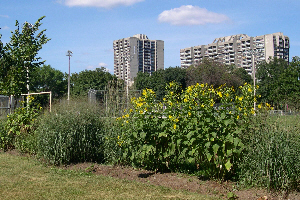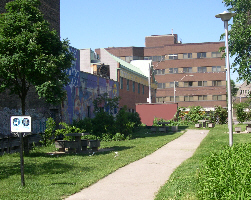In 1998, with the aim of bringing nature back to our cities, Evergreen started a series of community gardens called “Where Edges Meet” in three downtown Toronto neighbourhoods: Parkdale, the Annex and St. James Town. In the next year or so, a few others were initiated, but are no longer supported. The objective is to; “to bring communities and nature together for the benefit of both,” by helping neighbours and nature to connect through the creation of community native plant gardens. Two of these gardens are along the Taddle: “River of Grass” and Seaton Walk Parkette.

“River of Grass” in Moss Park
“River of Grass” in Moss Park, which was established in 2000, is one of those gardens that are no longer actively supported; however, it can still be viewed in the SW corner of Moss Park. The originators of this garden started with a vision: “Picture this. Moss Park, a barren corner of turf grass and asphalt in downtown Toronto transformed into a naturalized urban oasis. A river of native grasses swaying in the breeze as butterflies and humming birds nectar from wild bergamot, purple coneflower and towering cup plant. Long before Toronto became a network of roads and buildings, the site was the confluence of the now buried Taddle and Moss Park Creeks. Planting a river of native grasses mimics the flow of these historical rivers.”
The Annex “Where Edges Meet” garden, in Seaton Walk Parkette, lies near Taddle Creek’s Annex reach. Just fifty feet from the Bathurst streetcar platform lie two meadow gardens along Seaton Walk. People in this community members joined to breathe new life into Seaton Walk, planting 456 plants of 60 native species. the next year, they completed a second garden of sun-loving perennials, including the tall purple wands of Dense Blazing Star and aromatic Virginia Mountain Mint on the south side of the park.

Seaton Walk Parkette, May 2007
St. James Town West Park “Where Edges Meet” garden is the largest of the three original ones. With Four Directions, Meadow, Woodland, and Butterfly Gardens it keeps a score or so community gardeners very busy! It is off Sherbourne Street south of Bloor.
Evergreen started “Where Edges Meet” aiming to build a neighbourhood-based community naturalization projects. Community design workshops, planting parties, maintenance events, and educational activities have been held at each site. Evergreen’s “goal is to help build stronger, healthier communities by engaging people of diverse backgrounds in the creation of sustainable community naturalization gardens in City of Toronto Parks.”
Why use native plants? They are those plants that were growing in the area before the European settlers arrived. They have adapted to the local climate and soils. Evergreen encourages the use of native plants because they: are low maintenance. Once established, they cope better with the stresses of drought and disease, require less watering and care. they also provide food and habitat for local insects, birds, amphibians and mammals that have evolved in association with them. As a result, pest problems are minimal. They help to restore links between isolated natural areas. They increase local biodiversity and so contribute to global biodiversity. They create a rich environment for hands-on learning about our natural heritage. They encourage an ecological approach to gardening and how we can work with natural processes and local conditions. They provide landscaping that helps us understand our environment as a unique and complex web of connections and help us to understand what the land once looked like.
For more about this and other Evergreen activities see www.evergreen.ca
